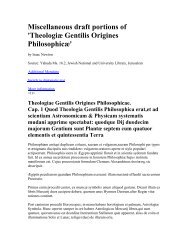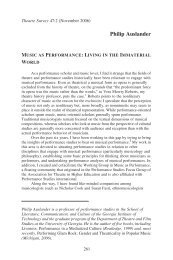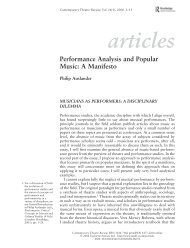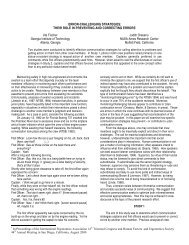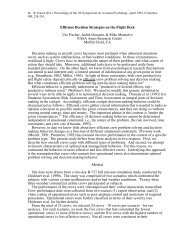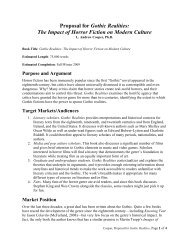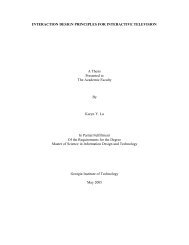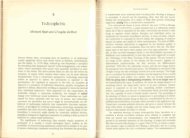Heidegger: The Question Concerning Technology In what follows ...
Heidegger: The Question Concerning Technology In what follows ...
Heidegger: The Question Concerning Technology In what follows ...
You also want an ePaper? Increase the reach of your titles
YUMPU automatically turns print PDFs into web optimized ePapers that Google loves.
<strong>Heidegger</strong>: <strong>The</strong> <strong>Question</strong> <strong>Concerning</strong> <strong>Technology</strong><strong>In</strong> <strong>what</strong> <strong>follows</strong> we shall be questioning concerning technology. <strong>Question</strong>ingbuilds a way. We would be advised, therefore, above all to pay heed to theway, and not to fix our attention on isolated sentences and topics. <strong>The</strong> wayis a way of thinking. All ways of thinking, more or less perceptibly, leadthrough language in a manner that is extraordinary. We shall be questioningconcerning technology, and in so doing we should like to prepare a freerelationship to it. <strong>The</strong> relationship will be free if it opens our humanexistence to the essence of technology.[1] When we can respond to thisessence, we shall be able to experience the technological within its ownbounds.<strong>Technology</strong> is not equivalent to the essence of technology. When we areseeking the essence of "tree," we have to become aware that That whichpervades every tree, as tree, is not itself a tree that can be encounteredamong all the other trees.Likewise, the essence of technology is by no means anything technological.Thus we shall never experience our relationship to the essence of technologyso long as we merely conceive and push forward the technological, put upwith it, or evade it. Everywhere we remain unfree and chained to technology,whether we passionately affirm or deny it. But we are delivered over to itin the worst possible way when we regard it as something neutral; for thisconception of it,2 to which today we particularly like to do homage, makesus utterly blind to the essence of technology.According to ancient doctrine, the essence of a thing is considered to be<strong>what</strong> the thing is. We ask the question concerning technology when we ask<strong>what</strong> it is. Everyone knows the two statements that answer our question. Onesays: <strong>Technology</strong> is a means to an end. <strong>The</strong> other says: <strong>Technology</strong> is a humanactivity. <strong>The</strong> two definitions of technology belong together. For to positends and procure and utilize the means to them is a human activity. <strong>The</strong>manufacture and utilization of equipment, tools, and machines, themanufactured and used things themselves, and the needs and ends that theyserve, all belong to <strong>what</strong> techherewith "to come to presence," a rendering wherein the meaning "endure"should be strongly heard. Occasionally it will be translated "to essence,"and its gerund will be rendered with "essencing." <strong>The</strong> noun Wesen willregularly be translated "essence" until <strong>Heidegger</strong>'s explanatory discussionis reached. <strong>The</strong>reafter, in this and the succeeding essays, it will often betranslated with "coming to presence." <strong>In</strong> relation to all these renderings,the reader should bear in mind a point that is of fundamental importance to<strong>Heidegger</strong>, namely, that the root of wesen, with its meaning "to dwell,"provides one integral component in the meaning of the verb sein (to be)..(Cf. An <strong>In</strong>troduction to Metaphysics, p. 59.)
2. "Conception" here translates the noun Vorstellung. Elsewhere in thisvolume, Vorstellung will usually be translated by "representation," and itsrelated verb vorstellen by "to represent." Both "conception" and"representation" should suggest a placing or setting-up-before. Cf. thediscussion of Vorstellung in AWP 131-132.<strong>The</strong> <strong>Question</strong> <strong>Concerning</strong> <strong>Technology</strong> 5nology is. <strong>The</strong> whole complex of these contrivances is technology. <strong>Technology</strong>itself is a contrivance, or, in Latin, an instrumentum .3<strong>The</strong> current conception of technology, according to which it is a means and ahuman activity, can therefore be called the instrumental and anthropologicaldefinition of technology.Who would ever deny that it is correct? It is in obvious conformity with<strong>what</strong> we are envisioning when we talk about technology. <strong>The</strong> instrumentaldefinition of technology is indeed so uncannily correct that it even holdsfor modern technology, of which, in other respects, we maintain with somejustification that it is, in contrast to the older handwork technology'something completely different and therefore new. Even the power plant withits turbines and generators is a man-made means to an end established byman. Even the jet aircraft and the hi-,h_ frequency apparatus are means toends. A radar station is of course less simple than a weather vane. To besure, the construction of a high-frequency apparatus requires theinterlocking of various processes of technical-industrial production. Andcertainly a sawmill in a secluded valley of the Black Forest is a primitivemeans compared with the hydroelectric plant in the Rhine River.But this much remains correct: modern technology too is a means to an end.That is why the instrumental conception of technology conditions everyattempt to bring man into the right relation to technology. Everythingdepends on our manipulating technology in the proper manner as a means. WeWill, as we say, 11 get" technology "spiritually in hand." We will masterit. <strong>The</strong> will to mastery becomes all the more urgent the more technologythreatens to slip from human control.But suppose now that technology were no mere means, how would it stand withthe will to master it? Yet we said, did we3. <strong>In</strong>strumentum signifies that which functions to heap or build up or toarrange. <strong>Heidegger</strong> here equates it with the noun Einrichtung, translated"Contrivance," which can also mean arrangement, adjustment, furnishing, orequipment. <strong>In</strong> accordance with his dictum that the true must be sought by wayof the correct, <strong>Heidegger</strong> here anticipates with his identification oftechnology as an instrumentum and an Einrichtung his later "true"characterization of technology in terms of setting-in-place, ordering,Enframing, and standing-re serve.
6 <strong>The</strong> <strong>Question</strong> <strong>Concerning</strong> <strong>Technology</strong>not, that the instrumental definition of technology is correct? To be sure.<strong>The</strong> correct always fixes upon something pertinent in <strong>what</strong>ever is underconsideration. However, in order to be correct, this fixing by no meansneeds to uncover the thing in question in its essence. Only at the pointwhere such an uncovering happens does the true come to pass.' For thatreason the merely correct is not yet the true. Only the true brings us intoa free relationship with that which concerns us from out of its essence.Accordingly, the correct instrumental definition of technology still doesnot show us technology's essence. <strong>In</strong> order that we may arrive at this, or atleast come close to it, we must seek the true by way of the correct. We mustask: What is the instrumental itself? Within <strong>what</strong> do such things as meansand end belong? A means is that whereby something is effected and thusattained. Whatever has an effect as its consequence is called a cause. Butnot only that by means of which something else is effected is a cause. <strong>The</strong>end in keeping with which the kind of means to be used is determined is alsoconsidered a cause. Wherever ends are pursued and means are employed,wherever instrumentality reigns, there reigns causality.For centuries philosophy has taught that there are four causes: (1) thecausa materialis, the material, the matter out of which, for example, asilver chalice is made; (2) the causa formalis, the form, the shape intowhich the material enters; (3) the causa finalis, the end, for example, thesacrificial rite in relation to which the chalice required is determined asto its form and matter; (4) the causa efficiens, which brings about theeffect that is the finished, actual chalice, in this instance, thesilversmith. What technology is, when represented as a means, disclosesitself when we trace instrumentality back to fourfold causality.But suppose that causality, for its part, is veiled in darkness with respectto <strong>what</strong> it is? Certainly for centuries we have acted as though the doctrineof the four causes had fallen from heaven as a truth as clear as daylight.But it might be that the time has come to ask, Why are there just fourcauses? <strong>In</strong> relation to the aforementioned four, <strong>what</strong> does "cause" reallymean? From4. "Come to pass" translates sich ereignet. For a discussion of the fullermeaning of the verb ereignen, see T 38 n. 4, 45.<strong>The</strong> <strong>Question</strong> <strong>Concerning</strong> <strong>Technology</strong> 7whence does it come that the causal character of the four causes is sounifiedly determined that they belong together?So long as we do not allow ourselves to go into these questions, causality,and with it instrumentality, and with the latter the accepted definition of
technology, remain obscure and groundless.For a long time we have been accustomed to representing cause as that whichbrings something about. <strong>In</strong> this connection, to bring about means to obtainresults, effects. <strong>The</strong> causa efficiens, but one among the four causes, setsthe standard for all causality. This goes so far that we no longer evencount the causa finalis,_t~ telic finality, as causality. Causa, casus,belongs to the verb cadere, "to fall," and means that which brings it aboutthat something falls out as a result in such and such a way. <strong>The</strong> doctrine ofthe four causes goes back to Aristotle. But everything that later ages seekin Greek thought under the conception and rubric "causality," in the realmof Greek thought and for Greek thought per se has simply nothing at all todo with bringing about and effecting. What we call cause [Ursache] and theRomans call causa is called aition by the Greeks, that to which somethingelse is indebted [das, was ein anderes verschuldet].' <strong>The</strong> four causes arethe ways, all belonging at once to each other, of being responsible forsomething else. An example can clarify this.Silver is that out of which the silver chalice is made. As this matter(hyle), it is co-responsible for the chalice. <strong>The</strong> chalice is indebted to,i.e., owes thanks to, the silver for that out of which it consists. But thesacrificial vessel is indebted not only to the silver. As a chalice, thatwhich is indebted to the silver appears in the aspect of a chalice and notin that of a brooch or a ring. Thus the sacrificial vessel is at the sametime indebted to the aspect (eidos) of chaliceness. Both the silver intowhich the aspect is admitted as chalice and the aspect in which the silverappears are in their respective ways co-responsible for the sacrificialvessel.5. Das, was ein anderes verschuldet is a quite idomatic expression that herewould mean to many German readers "that which is the cause of somethingelse." <strong>The</strong> verb verschulden actually has a wide range of meanings-to beindebted, to owe, to be guilty, to be responsible for or to, to cause.<strong>Heidegger</strong> intends to awaken all these meanings and to have connotations ofmutual interdependence sound throughout this passage.8 <strong>The</strong> <strong>Question</strong> <strong>Concerning</strong> <strong>Technology</strong>But there remains yet a third that is above all responsible for thesacrificial vessel. It is that which in advance confines the chalice withinthe realm of consecration and bestowal.6 Through this the chalice iscircumscribed as sacrificial vessel. Circumscribing gives bounds to thething. With the bounds the thing does not stop; rather from out of them itbegins to be <strong>what</strong>, after production, it will be. That which gives bounds,that which completes, in this sense is called in Greek telos, which is alltoo often translated as "aim" or "purpose," and so misinterpreted. <strong>The</strong> telosis responsible for <strong>what</strong> as matter and for <strong>what</strong> as aspect are togetherco-responsible for the sacrificial vessel.
Finally there is a fourth participant in the responsibility for the finishedsacrificial vessel's lying before us ready for use, i.e., thesilversmith-but not at all because he, in working, brings about the finishedsacrificial chalice as if it were the effect of a making; the silversmith isnot a causa efficiens.<strong>The</strong> Aristotelian doctrine neither knows the cause that is named by this termnor uses a Greek word that would correspond to it.<strong>The</strong> silversmith considers carefully and gathers together the threeaforementioned ways of being responsible and indebted. To consider carefully[iiberlegen] is in Greek legein, logos. Legein is rooted in apophainesthai,to bring forward into appearance. <strong>The</strong> silversmith is co-responsible as thatfrom whence the sacrificial vessel's bringing forth and resting-in-self takeand retain their first departure. <strong>The</strong> three previously mentioned ways ofbeing responsible owe thanks to the pondering of the silversmith for the"that" and the "how" of their coming into appearance and into play for theproduction of the sacrificial vessel.Thus four ways of being responsible hold sway in the sacrificial vessel thatlies ready before us. <strong>The</strong>y differ from one another, yet they belongtogether. What unites them from the beginning? <strong>In</strong> <strong>what</strong> does this playing inunison of the four ways of being6. Literally, "confines into"--the German preposition in with theaccusative. <strong>Heidegger</strong> often uses this construction in ways that are unusualin German, as they would be in English. It will ordinarily be translatedhere by "within" so as to distinguish it from "in" used to translate in withthe dative.<strong>The</strong> <strong>Question</strong> <strong>Concerning</strong> <strong>Technology</strong> 9responsible play? What is the source of the unity of the four causes? What,after all, does this owing and being responsible mean, thought as the Greeksthought it?Today we are too easily inclined either to understand being responsible andbeing indebted moralistically as a lapse, or else to construe them in termsof effecting. <strong>In</strong> either case we bar to ourselves the way to the primalmeaning of that which is later called causality. So long as this way is notopened up to us we shall also fail to see <strong>what</strong> instrumentality, which isbased on causality, actually is.<strong>In</strong> order to guard against such misinterpretations of being responsible andbeing indebted, let us clarify the four ways of being responsible in termsof that for which they are responsible. According to our example, they areresponsible for the silver chalice's lying ready before us as a sacrificial
vessel. Lying before and lying ready (hypokeisthai) characterize thepresencing of something that presences. <strong>The</strong> four ways of being responsiblebring something into appearance. <strong>The</strong>y let it come forth into presencing[An-wesen].' <strong>The</strong>y set it free to that place and so start it on its way,namely, into its complete arrival. <strong>The</strong> principal characteristic of beingresponsible is this starting something on its way into arrival. It is in thesense of such a starting something on its way into arrival that beingresponsible is an occasioning or an inducing to go forward [Ver-an-lassen].'On the7. By writing An-wesen, <strong>Heidegger</strong> stresses the composition of the verbanwesen, translated as "to presence." <strong>The</strong> verb consists of wesen (literally,to continue or endure) with the prepositional prefix an- (at, to, toward).It is man who must receive presencing, man to whom it comes as enduring. Cf.On Time and Being, trans. Joan Stambaugh (New York: Harper & Row, 1972), p.12.8. Ver-an-lassen is <strong>Heidegger</strong>'s writing of the verb veranlassen in nounform, now hyphenated to bring out its meaning. Veranlassen ordinarily meansto occasion, to cause, to bring about,'to call forth. Its use here relatesback to the use of antassen (to leave [something] on, to let loose, to setgoing), here translated "to start something on its way." Anlassen has justbeen similarly written as an-lassen so as to emphasize its composition fromlassen (to let or leave) and an (to or toward). One of the functions of theGerman prefix ver- is to intensify the force of a verb. Andr6 Pr6au quotes<strong>Heidegger</strong> as saying: "Ver-an-lassen is more active than an-lassen. <strong>The</strong> ver-,as it were, pushes the latter toward a doing [vers un fairel." Cf. Martin<strong>Heidegger</strong>, Essais et Conf6rences (Paris: Gallimard, 1958), p. 16 n.10 <strong>The</strong> <strong>Question</strong> <strong>Concerning</strong> <strong>Technology</strong>basis of a look at <strong>what</strong> the Greeks experienced in being responsible, inaitia, we now give this verb "to occasion" a more inclusive meaning, so thatit now is the name for the essence of causality thought as the Greeksthought it. <strong>The</strong> common and narrower meaning of "occasion" in contrast isnothing more than striking against and releasing, and means a kind ofsecondary cause within the whole of causality.But in <strong>what</strong>, then, does the playing in unison of the four ways ofoccasioning play? <strong>The</strong>y let <strong>what</strong> is not yet present arrive into presencing.Accordingly, they are unifiedly ruled over by a bringing that brings <strong>what</strong>presences into appearance. Plato tells us <strong>what</strong> this bringing is in asentence from the Symposium (205b): he gar toi ek tou me onton eis to onionti hot5ioun aitia pasa esti poiesis. "Every occasion for <strong>what</strong>ever passesover and goes forward into presencing from that which is not presencing ispoiesis, is bringing-forth [Her-vor-bringen]."'It is of utmost importance that we think bringing-forth in its full scope
and at the same time in the sense in which the Greeks thought it. Not onlyhandcraft manufacture, not only artistic and poetical bringing intoappearance and concrete imagery, is a bringing-forth, poiesis. Physis also,the arising of something from out of itself, is a bringing-forth, poiPsis.Physis is indeed pot . est . s in the highest sense. For <strong>what</strong> presences bymeans of physi . s has the bursting open belonging to bringing-forth, e.g.,the bursting of a blossom into bloom, in itself (en heaut5i). <strong>In</strong> contrast,<strong>what</strong> is brought forth by the artisan or the artist, e.g.,9. <strong>The</strong> full gamut of meaning for the verb hervorbringen, here functioning asa noun, includes to bring forth or produce, to generate or beget, to utter,to elicit. <strong>Heidegger</strong> intends that all of these nuances be heard. Hehyphenates the word in order to emphasize its adverbial prefixes, her(hereor hither) and vor- (forward or forth). <strong>Heidegger</strong> elsewhere makes specificthe meaning resident in Her-vor-bringen for him by utilizing those prefixesindependently. Thus he says (translating literally), "Bringing-forthhitherbrings hither out of concealment, forth into unconcealment" (cf. below, P.11); and-after identifying working (wirken) and her-vor-bringenhe says thatworking must be understood as "bringing hither-into u nconcealment,forth-into presencing" (SR 161). Because of the awkwardness of the Englishphrase "to bring forth hither," it has not been possible to include in thetranslation of her-vor-bringen the nuance of meaning that her- provides.<strong>The</strong> <strong>Question</strong> <strong>Concerning</strong> <strong>Technology</strong> 11the silver chalice, has the bursting open belonging to bringingforth not initself, but in another (en all6i), in the craftsman or artist.<strong>The</strong> modes of occasioning, the four causes, are at play, then, withinbringing-forth. Through bringing-forth, the growing things of nature as wellas <strong>what</strong>ever is completed through the crafts and the arts come at any giventime to their appearance.But how does bringing-forth happen, be it in nature or in handwork and art?What is the bringing-forth in which the fourfold way of occasioning plays?Occasioning has to do with the presencing [Anwesen] of that which at anygiven time comes to appearance in bringing-forth. Bringing-forth bringshither out of concealment forth into unconcealment. Bringing-forth comes topass only insofar as something concealed comes into unconcealment. Thiscoming rests and moves freely within <strong>what</strong> we call reveali [das Entbergen].'o<strong>The</strong> Greeks have the word10. <strong>The</strong> verb entbergen (to reveal) and the allied noun Entbergung(revealing) are unique to <strong>Heidegger</strong>. Because of the exigencies oftranslation, entbergen must usually be translated with "revealing," and thepresence of Entbergung, which is rather infrequently used, has thereforeregrettably been obscured for want of an appropriate English noun asalternative that would be sufficiently active in meaning. Entbergen and
Entbergung are formed from the verb bergen and the verbal prefix ent- Bergenmeans to rescue, to recover, to secure, to harbor, to conceal. Ent- is usedin German verbs to connote in one way or another a change from an existingsituation. It can mean "forth" or "out" or can connote a change that is thenegating of a former condition. Entbergen connotes an opening out fromprotective concealing, a harboring forth. For a presentation of <strong>Heidegger</strong>'scentral tenet that it is only as protected and preserved-and that means asenclosed and secure-that anything is set free to endure, to continue as thatwhich it is, i.e., to be, see "Building Dwelling Thinking" in Poetry,Language, Thought, trans. Albert Hofstadter (New York: Harper & Row, 1971),p. 149, and cf. p. 25 below.Entbergen and Entbergung join a family of words all formed from bergen-verbergen (to conceal), Verborgenheit (concealment), das Verborgene (theconcealed), Unverborgenheit (unconcealment), das Unverborgene (theunconcealed)-of which <strong>Heidegger</strong> makes frequent use. <strong>The</strong> lack of viableEnglish words sufficiently numerous to permit a similar use of but onefundamental stem has made it necessary to obscure, through the use of"reveal," the close relationship among all the words just mentioned. None ofthe English words used-"reveal ... .. conceal," "unconceal'~-evinces withany adequacy the meaning resident in bergen itself; yet the reader should beconstantly aware that the full range of connotation present in bergen soundsfor <strong>Heidegger</strong> within all these, its derivatives.12 <strong>The</strong> <strong>Question</strong> <strong>Concerning</strong> <strong>Technology</strong> 0aI442,eia for revealing. <strong>The</strong> Romans translate this with ve 'tWe say "truth" and usually understand it as the correctness of an idea.But where have we strayed to? We are questioning concerning technology, andwe have arrived now at alotheia, at revealing. What has the essence oftechnology to do with revealing? <strong>The</strong> answer: everything. For everybringing-forth is grounded in revealing. Bringing-forth, indeed, gatherswithin itself the four modes of occasioning-causality-and rules themthroughout. Within its domain belong end and means, belongsinstrumentality." <strong>In</strong>strumentality is considered to be the fundamentalcharacteristic of technology. If we inquire, step by step, into <strong>what</strong>technology, represented as means, actually is, then we shall arrive atrevealing. <strong>The</strong> possibility of all productive manufacturing lies inrevealing.<strong>Technology</strong> is therefore no mere means. <strong>Technology</strong> is a way of revealing. Ifwe give heed to this, then another whole realm for the essence of technologywill open itself up to us. It is the realm of revealing, i.e., of truth. 12This prospect strikes us as strange. <strong>In</strong>deed, it should do so, should do soas persistently as possible and with so much urgency that we will finally
take seriously the simple question of <strong>what</strong> the name "technology" means. <strong>The</strong>word stems from the Greek. Technikon means that which belongs to technP. Wemust observeii. Here and elsewhere "belongs within" translates the German geh6rt in withthe accusative (literally, belongs into), an unusual usage that <strong>Heidegger</strong>often employs. <strong>The</strong> regular German construction is gehdrt zu (belongs to).With the use of "belongs into," <strong>Heidegger</strong> intends to suggest a relationshipinvolving origin.12. <strong>Heidegger</strong> here hyphenates the word Wahrheit (truth) so as to expose itsstem, wahr. He points out elsewhere that words with this stem have a commonderivation and underlying meaning (SR 165). Such words often show theconnotations of attentive watchfulness and guarding that he there finds intheir Greek cognates, horao, ora, e.g., wahren (to watch over and keep safe)and bewahren (to preserve). Hyphenating Wahrheit draws it overtly into thiscircle of meaning. It points to the fact that in truth, which isunconcealment (Unverborgenheit), a safekeeping carries itself out. Wahrheitthus offers here a very close parallel to its companion noun Entbergung(revealing; literally, harboring forth), built on bergen (to rescue, toharbor, to conceal). See n. 10, above. For a further discussion of wordsbuilt around wahr, see T 42, n. 9.<strong>The</strong> <strong>Question</strong> <strong>Concerning</strong> <strong>Technology</strong> 13two things with respect to the meaning of this word. One is that techni isthe name not only for the activities and skills of the craftsman, but alsofor the arts of the mind and the fine arts. Techne belongs tobringing-forth, to poijsis; it is something poietic.<strong>The</strong> other point that we should observe with regard to techni is even moreimportant. From earliest times until Plato the word techne is linked withthe word epistinio. Both words are names for knowing in the widest'sense.<strong>The</strong>y mean to be entirely at home in something, to understand and be expertin it. Such knowing provides an opening up. As an opening up it is arevealing. Aristotle, in a discussion of special importance (NicomacheanEthics, Bk. VI, chaps. 3 and 4), distinguishes between epistPmO and technPand indeed with respect to <strong>what</strong> and how they reveal. Techne is a mode ofalitheuein. It reveals <strong>what</strong>ever does not bring itself forth and does not yetlie here before us, <strong>what</strong>ever can look and turn out now one way and nowanother. Whoever builds a house or a ship or forges a sacrificial chalicereveals <strong>what</strong> is to be brought forth, according to the perspectives of thefour modes of occasioning. This revealing gathers together in advance theaspect and the matter of ship or house, with a view to the finished thingenvisioned as completed, and from this gathering determines the manner ofits construction. Thus <strong>what</strong> is decisive in technz! does not lie at all inmaking and manipulating nor in the using of means, but rather in theaforementioned revealing. It is as revealing, and not as manufacturing, that
techne is a bringing-forth.Thus the clue to <strong>what</strong> the word technE means and to how the Greeks defined itleads us into the same context that opened itself to us when we pursued thequestion of <strong>what</strong> instrumentality as such in truth might be.<strong>Technology</strong> is a mode of revealing. <strong>Technology</strong> comes to presence [West] inthe realm where revealing and unconcealment take place, where aletheia,truth, happens.in opposition to this definition of the essential domain of technology, onecan object that it indeed holds for Greek thought and that at best it mightapply to the techniques of the handcraftsman, but that it simply does notfit modern machine-powered technology. And it is precisely the latter and14 <strong>The</strong> <strong>Question</strong> <strong>Concerning</strong> <strong>Technology</strong>it alone that is the disturbing thing, that moves us to ask the questionconcerning technology per se. It is said that modern technology is somethingincomparably different from all earlier technologies because it is based onmodern physics as an exact science. Meanwhile we have come to understandmore clearly that the reverse holds true as well: Modern physics, asexperimental, is dependent upon technical apparatus and upon progress in thebuilding of apparatus. <strong>The</strong> establishing of this mutual relationship betweentechnology and physics is correct. But it remains a merely historiographicalestablishing of facts and says nothing about that in which this mutualrelationship is grounded. <strong>The</strong> decisive question still remains: Of <strong>what</strong>essence is modern technology that it happens to think of putting exactscience to use?What is modern technology? It too is a revealing. Only when we allow ourattention to rest on this fundamental characteristic does that which is newin modern technology show itself to us.And yet the revealing that holds sway throughout modern technology does notunfold into a bringing-forth in the sense of poijsis. <strong>The</strong> revealing thatrules in modern technology is a challenging [Herausfordern] '13 which putsto nature the unreasonable demand that it supply energy that can beextracted and stored as such. But does this not hold true for the oldwindmill as well? No. Its sails do indeed turn in the wind; they are leftentirely to the wind's blowing. But the windmill does not unlock energy fromthe air currents in order to store it.<strong>In</strong> contrast, a tract of land is challenged into the putting out of coal andore. <strong>The</strong> earth now reveals itself as a coal mining district, the soil as amineral deposit. <strong>The</strong> field that the peasant .formerly cultivated and set inorder [bestelltel appears differently than it did when to set in order stillmeant to take care of and
13. Herausfordern means to challenge, to call forth or summon to action, todemand positively, to provoke. It is composed of the verb fordern (todemand, to summon, to challenge) and the adverbial prefixes her- (hither)and aus- (out). <strong>The</strong> verb might be rendered very literally as "to demand outhither." <strong>The</strong> structural similarity between herausfordern and her-vorbringen(to bring forth hither) is readily apparent. It serves of itself to point upthe relation subsisting between the two modes of revealing of which theverbs speak-modes that, in the very distinctive ways peculiar to them,occasion a coming forth into unconcealment and presencing. See below, 29-30.<strong>The</strong> <strong>Question</strong> <strong>Concerning</strong> <strong>Technology</strong> 15to maintain. <strong>The</strong> work of the peasant does not challenge the soil of thefield. <strong>In</strong> the sowing of the grain it places the seed in the keeping of theforces of growth and watches over its increase. But meanwhile even thecultivation of the field has come under the grip of another kind ofsetting-in-order, which sets upon [stellt] nature. 14 It sets upon it in thesense of challenging it. Agriculture is now the mechanized food industry.Air is now set upon to yield nitrogen, the earth to yield ore, ore to yielduranium, for example; uranium is set upon to yield atomic energy, which canbe released either for destruction or for peaceful use.This setting-upon that challenges forth the energies of nature is anexpediting [Fbrdern], and in two ways. It expedites in that it unlocks andexposes. Yet that expediting is always itself directed from the beginningtoward furthering something else, i.e., toward driving on to the maximumyield at the minimum expense. <strong>The</strong> coal that has been hauled out in somemining district has not been supplied in order that it may simply be presentsomewhere or other. It is stockpiled; that is, it is on call, ready todeliver the sun's warmth that is stored in it. <strong>The</strong> sun's warmth ischallenged forth for heat, which in turn is ordered to deliver steam whosepressure turns the wheels that keep a factory running.14. <strong>The</strong> verb stellen (to place or set) has a wide variety of uses. It canmean to put in place, to order, to arrange, to furnish or supply, and, in amilitary context, to challenge or engage. Here <strong>Heidegger</strong> sees theconnotations of herausfordern (to challenge, to call forth, to demand outhither) as fundamentally determinative of the meaning of stellen, and thisremains true throughout his ensuing discussion. <strong>The</strong> translation of stellenwith "to set upon" is intended to carry this meaning. <strong>The</strong> connotations ofsetting in place and of supplying that lie within the word stellen remainstrongly present in <strong>Heidegger</strong>'s repeated use of the verb hereafter, however,since the "setting-upon" of which it speaks is inherently a setting in placeso as to supply. Where these latter meanings come decisively to the fore,stellen has been translated with "to set" or "to set up," or, rarely, with"to supply."
<strong>The</strong> <strong>Question</strong> <strong>Concerning</strong> <strong>Technology</strong> 17What kind of unconcealment is it, then, that is peculiar to that which comesto stand forth through this setting-upon that challenges? Everywhereeverything is ordered to stand by, to be immediately at hand, indeed tostand there just so that it may be on call for a further ordering. Whateveris ordered about in this way has its own standing. We call it thestanding-reserve [Bestandj." <strong>The</strong> word expresses here something more, andsomething more essential, than mere "stock." <strong>The</strong> name "standingreserve"assumes the rank of an inclusive rubric. It designates nothing less than theway in which everything presences that is wrought upon by the challengingrevealing. Whatever stands by in the sense of standing-reserve no longerstands over against us as object.Yet an airliner that stands on the runway is surely an object. Certainly. Wecan represent the machine so. But then it conceals itself as to <strong>what</strong> and howit is. Revealed, it stands on the taxi strip only as standing-reserve,inasmuch as it is ordered to ensure the possibility of transportation. Forthis it must be in its whole structure and in every one of its constituentparts, on call for duty, i.e., ready for takeoff. (Here it would beappropriate to discuss Hegel's definition of the machine as an autonomoustool. When applied to the tools of the craftsman, his characterization iscorrect. Characterized in this way, however, the machine is not thought atall from out of the essence of technology within which it belongs. Seen interms of the standing-reserve, the machine is completely unautonomous, forit has its standing only from the ordering of the orderable.)<strong>The</strong> fact that now, wherever we try to point to modern technology as thechallenging revealing, the words "setting-upon," "Ordering,""standing-reserve," obtrude and accumulate in a dry, monotonous, andtherefore oppressive way, has its basis in <strong>what</strong> is now coming to utterance.16. Bestand ordinarily denotes a store or supply as "standing by." Itcarries the connotation of the verb bestehen with its dual meaning of tolast and to undergo. <strong>Heidegger</strong> uses the word to characterize the manner inwhich everything commanded into place and ordered according to thechallenging demand ruling in modern technology presences as revealed. Hewishes to stress here not the permanency, but the orderability andsubstitutability of objects. Bestand contrasts with Gegenstand (object; thatwhich stands over against). Objects indeed lose their character as objectswhen they are caught up in the "standing-reserve." Cf. <strong>In</strong>troduction, p.xxix.------------------------------------------------------------------------1. "Essence" is the traditional translation of the German noun Wesen. Oneof <strong>Heidegger</strong>'s principal aims in this essay is to seek the true meaningof essence through or by way of the "correct" meaning. He will latershow that Wesen does not simply mean <strong>what</strong> something is, but that it
means, further, the way in which something pursues its course, the wayin which it remains through time as <strong>what</strong> it is. <strong>Heidegger</strong> writeselsewhere that the noun Wesen does not mean quidditas originally, butrather "enduring as presence" (das Wahren als Gegenwart). (See An<strong>In</strong>troduction to Metaphysics, trans. Ralph Manheim [New York: Doubleday,1961], p. 59.) Wesen as a noun derives from the verb wesen, which isseldom used as such in modern German. <strong>The</strong> verb survives primarily ininflected forms of the verb sein (to be) and in such words as theadjective anwesend (present). <strong>The</strong> old verbal forms from which wesenstems meant to tarry or dwell. <strong>Heidegger</strong> repeatedly identifies wesen as"the same as w4hren [to last or endure]." (See p. 30 below and SR 161.)As a verb, wesen will usually be translated




